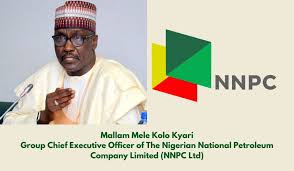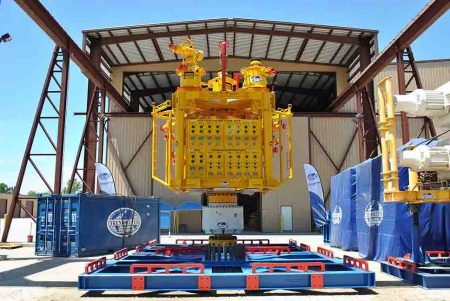*Experts, inside sources, stakeholders fault NNPC *Plant refining only 6,500 barrels of crude *Rehabilitation work not yet completed

Chuks Isiwu & Mkpoikana Udoma
Lagos/Port Harcourt – Experts, stakeholders and inside sources at the Port Harcourt Refinery are faulting the recent Nigerian National Petroleum Company Limited, NNPC, claims on the return of the 60,000 barrels per day old Port Harcourt refinery to operations. They described the claims as amounting to national deceit.
Investigations at the refinery showed that the plant currently refines only 6,500 barrels of crude oil some days (not even on a daily basis), which can only load 10 trucks. Industry experts say this is insignificant when compared to the refinery’s 60,000 barrels per day refining capacity and its loading capacity of 180 to 200 trucks daily.
According to the experts, a refinery of 60,000 per day capacity that is processing only 6,500 barrels cannot be described as working.
“As it stands now, it is only the CDU (Crude Distillation Unit) that refines just 6,500 barrels per day and produces nothing more than 10 trucks maximum per day that is working,” Alex Ogedegbe, a chemical engineer, expert refiner and former Managing Director of the Port Harcourt Refinery and the Warri Refinery, told SweetcrudeReports.
He added: “It is not the full refinery that is functioning. No refiner can claim that with only one unit running, and for that, the Port Harcourt refinery has begun operations and thus issues fake figures to Nigerians.
“You cannot be operating a refinery that has 60,000 barrels per day capacity and you are producing 6,500 barrels which is about 10 percent, and then announced to the world that the Port Harcourt refinery has come on stream.”
The NNPC had celebrated the return of the refinery to operation following a rehabilitation exercise that lasted over three years, announcing on November 26. 2024 the commencement of petroleum products production and loading of fuel trucks at the 59 years old plant.
The company, in announcing the development, had disclosed that the refinery was running at 70 percent capacity and would be loading 200 trucks per day.
An elated President Bola Tinubu, the Minister of State for Petroleum Resources, Senator Heineken Lokpobiri, and the Petroleum Products Retail Outlet Owners Association of Nigeria, PETROAN, hailed the development as a key milestone for Nigeria’s energy sector and a major push for the nation’s economic revival.
But, a community leader, Timothy Mgbere, who is the Secretary of stakeholders of the Alesa community – one of the host communities to the refinery – immediately tackled the NNPC, claiming that the state oil company lied about the completion of rehabilitation work on the plant and its return to operations.
Mgbere, in an interview with Arise TV, maintained that the refinery was not operating to the capacity claimed by the NNPC and that the petrol, also known as Premium Motor Spirit, PMS, loaded from the facility on Tuesday, November 26, to mark its return to production, was not new product but an old one stocked in the new Port Harcourt Refinery section for the past three years.
Community leader vs NNPC
He alleged that only six trucks of petroleum products were loaded from the refinery on that Tuesday, contrary to NNPC’s claim that 200 trucks would be loaded at the refinery daily.
“The Port Harcourt refinery, and by extension, the Port Harcourt depot, happens to be the mainstay of the Alesa community economy. The economic activities emanating from the operations of these depots mean a lot to us as a community people, but as it were, now, I don’t think it’s a cause for celebration yet because what we are having in the media space is different from what we have on the ground.
“I can tell you on authority as a community person, that what happened on Tuesday was just a mere show at the Port Harcourt depot. A mere show in the sense that the Port Harcourt refinery, we call it area five, that is the old refinery, is merely in skeletal operation. When I say skeletal, I mean that some units of the refinery were brought up and are running, but not the entire unit of the old refinery is functional, as we speak,” he said.
The NNPC was to counter Mgbere’s claim in a statement by its spokesperson, Olufemi Soneye, saying the community leader was ignorant of how a refinery runs. Part of the statement read: “He (Mgbere) claimed that the old Port Harcourt Refinery was only operating skeletally and was not processing PMS. His proof was that the PMS truck-out was done at the gantry of the new Port Harcourt Refinery as against the gantry of the old Port Harcourt Refinery.
“This betrays his scant knowledge of the operations of the refinery. The old and new Port Harcourt Refineries have since been integrated with one single terminal for product load-out.
“They share common utilities like power and storage tanks. This means that storage tanks and loading gantry which he claimed belongs to the new Port-Harcourt Refinery can also receive products from the Old Port Harcourt Refinery”.
However, in a recent interview with SweetcrudeReports, Mgbere, a former refinery employee, who worked in the operations department, maintained his position on the state of affairs at the refinery and pointed out the discrepancy between public statements from NNPC and the reality on the ground. He said: “On the 26th of November, after the party by NNPC, only six trucks were loaded. On the 27th, 28th and 29th, only four trucks each day. On the 30th of November, there was no loading at all. This is hardly what you would call operational success. Despite the public claims of success, we are not even close to achieving the capacity needed to supply the local market.
“On Sunday, December 1st, 2024, they brought journalists to discredit me after my interview, journalists who couldn’t ask the right questions. On that Sunday, they loaded to a point and then shut down and waited for the media to come before they began loading again so the media could capture it. At the end of the day, they loaded only 17 trucks.
“On December 2nd, 2024, only six trucks were loaded. On December 3rd, there was no loading at all. On December 4th, only 10 trucks were loaded. 19 trucks were loaded on Thursday, December 5th. And that only happened when they noticed the presence of independent journalists who were around to observe the situation. I dare NNPC to dispute these figures.”
Mgbere explained that the Port Harcourt refinery depot before now loaded out over 200 trucks per day and minimum of 180 trucks, made up of PMS, Dual Purpose Kerosene, DPK, and others; while explaining that even private depots do not load four trucks in a day.
 He continued: “And so when NNPC claims the Port Harcourt refinery is producing at 70 percent, you can understand where my anger is coming from. Till now, NNPC has not been able to prove me wrong. Is it 4 to 19 trucks of PMS that are coming out from the product line that is 70 percent?
He continued: “And so when NNPC claims the Port Harcourt refinery is producing at 70 percent, you can understand where my anger is coming from. Till now, NNPC has not been able to prove me wrong. Is it 4 to 19 trucks of PMS that are coming out from the product line that is 70 percent?
“It’s only when they are loading up to 150 trucks per day, that’s when they can convince Nigerians like me that the Port Harcourt refinery is operational, talk less of the than 90 percent they claim.
“Can you visit a private depot in Lagos and see what their daily loadout is? And we are talking about NNPC depot, which is the mother depot, that controls Makurdi, Aba, Calabar, Port Harcourt, Enugu, Gombe, and then you’re loading between 3-19 trucks and you say you’re producing.”
Mgbere also explained that the contractor handling the rehabilitation of the refinery was still working on the line that will connect the old refinery (the one NNPC says has come on stream) to the storage of the new Port Harcourt Refinery.
“So, there is no connectivity with what they have refined going into the new truck area of the new refinery area, where they are loading from right now. They have two pipes – 10 inches pipe by 7 metres they are trying to install to create connectivity between where they are storing, where they are refining to the new truck area.
“So, they are still pushing out their old stocks. There is a storage area in the refinery called Unit 52. Those tanks are storage, and that is where they are pushing from.”
Similarly, Alex Ogedegbe, the former Managing Director of the Port Harcourt Refinery and the Warri Refinery, faulted the NNPC on the return of the old refinery and its functioning at 70 percent. “I think all these are politically motivated. And I think the government is not being sincere with Nigerians. As it stands now, it is only the CDU (Crude Distillation Unit) that refines just 6,500 barrels per day and produces nothing more than 10 trucks maximum per day that is working,” Ogedegbe said.
He added: “It is not the full refinery that is functioning. No refiner can claim that with only one unit running, and for that, the Port Harcourt refinery has begun operations and thus issues fake figures to Nigerians.
“NNPC and the Federal Government over the years have so much disappointed Nigerians in terms of local refining and I guess just because they have achieved 60 percent completion of the Topping Unit, they began issuing figures of production, which is not true.
“What is happening at the Port Harcourt Refinery right now is not more than a modular refinery, that’s the Topping Unit, also known as the Crude Distillation Unit.
“There’s another unit called Platformer. This platformer has not been fixed as we speak. Even if the platformer has been fixed, it will not increase the quantity of production, instead it will enhance the product quality by taking products from the CDU and refining it better.
“This Topping Unit that they have commissioned produces nothing more than 6,500 barrels per day, which is a maximum of 10 trucks daily.”
Government’s insincerity
The government’s portrayal of the refinery’s progress has been characterised by a series of false claims and contradictions. NNPC officials have also frequently touted the rehabilitation of the refinery as a success, but insiders suggest that the refinery is far from being fully operational.
Engr. Ogedegbe did not mince words while describing the government’s misleading narrative. “The refinery is not functioning as they claim. The Crude Distillation Unit (CDU) produces only 6,500 barrels per day, about 10 truckloads, which is a far cry from what is expected,” he said.
Government officials, including the Minister of State for Petroleum Resources, have repeatedly told the public that the refinery is producing refined products at an increasing rate. However, experts argue that these claims are inflated and intended to maintain political support for the current administration’s handling of the oil sector.
Ogedegbe went on to highlight the gaps in the government’s messaging. “The refinery is far from being a functioning facility, and yet NNPC is issuing figures to the public,” he asserted.
“We are also told that the Port Harcourt refinery is getting C5 from Indorama to blend with Naphta for them to get PMS. During my time in the Refinery, we never ever made use of C5 in production. The Port Harcourt refinery has never used C5 in production until now. C5 are byproducts from petrochemicals and Indorama used to send them to us for export and not to be used in refining.
“I am saying it is also possible that products can be imported into the Refinery because it has a large storage facility, so it could also be that the government may decide to keep deceiving Nigerians.
“The government needs to be sincere with the people. The Refinery as it stands now is not working. You cannot be operating a refinery that has 60,000 barrels per day capacity and you are producing 6,500 barrels which is about 10 percent, and then announced to the world that the Port Harcourt refinery has come on stream.
“If the contractor which you gave $1.5 billion to execute the rehabilitation is not working, can’t you fire that contractor and get somebody who is more reliable and with the expertise to get the job done?” Ogedegbe further stated.
He spoke of what the Port Harcourt Refinery ought to be doing currently: “In 1991, when I was the Managing Director of the Port Harcourt refinery, we used to send 30,000 tonnes of products to Lagos through the jetty. Today, the jetty is completely broken and not working. In 1991, we were exporting refined petroleum products to Ghana, Sierra Leone and other West African countries, but today the political class has killed everything. They prefer to import because they make money from imports. In 1975, I was the Managing Director of Warri Refinery, and it’s so painful to watch our refineries, which were working at optimum capacity, now being killed by politicians.
“Mele Kyari doesn’t know anything about refining, he is a geologist. He doesn’t know anything about a refinery and has never worked in a refinery. Never in the history of Nigeria has there been a change of government and the Managing Director of NNPC has not changed.”
Government’s deception
Also, Mgbere, the Alesa community leader, said he was not surprised with the government’s current deception on the Port Refinery. “In December 2023, they lit up flares and celebrated that the refinery had been rehabilitated, but what they didn’t tell Nigerians was that two days later there was a shutdown. They brought gas through commercial gas trucks to achieve that one-night flare but the following day, the flare went off because it was a deception.
“This is not the first time NNPC will claim it has rehabilitated the old refinery. They have done it before, polished it, and shut it down. So, it has become a norm.
“Yes, rehabilitation (of the old Port Harcourt Refinery) is ongoing, but there are a lot of internal issues in that facility. Internal issues like payment of twopence to workers.
“Tecnimont is there but has no equipment. They are just there playing a supervisory role and have sub-let the contract to another company and the company also sub-let to another company.”
About Port Harcourt Refinery
Located in the heart of Nigeria’s oil-rich Niger Delta region, the Port Harcourt refinery, a cornerstone of Nigeria’s oil industry, has long been a symbol of both ambition and failure in the sector.
The Port Harcourt Refinery consists of two plants: the old refinery, often referred to as Area 5, which was built in 1965 and has a capacity to refine 60,000 barrels per day. bpd; and the newer refinery, commissioned in 1988, with a significantly larger refining capacity of 150,000bpd.
Over the years, however, it has been beset by underinvestment, outdated infrastructure, and inefficient management. The old refinery stopped working in 1988, when the new refinery came on stream and since then has not been in use despite a series of funds put into it for rehabilitation between 1993 and now.
By the early 2000s, the new refinery’s performance had significantly declined, with frequent breakdowns and severe operational inefficiencies. Successive governments promised to revitalise both refineries, but the promises remained unfulfilled.
Hopes were reignited in 2021, when the Nigerian National Petroleum Company Ltd launched a fresh attempt at rehabilitating the two refineries and awarded a $1.5 billion contract for the rehabilitation of the two refineries to Italian firm Maire Tecnimont. Yet, three years on, the refinery’s much-anticipated revival remained mired in controversy, with Nigerians questioning whether they will ever see the promised improvements.
Government’s recent claims that the old refinery, also known as Area 5, has resumed operations at 70 percent are being faulted by experts, inside sources at the refinery as well as stakeholders.



